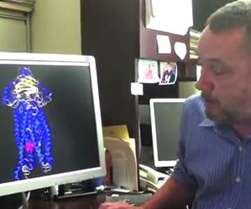SMU biochemists super-compute a cancer drug

When chemotherapy fails to halt the spread of cancer, it is typically because new super cells develop resistance to the chemotherapy. Instead of dying off, the cells reject the medicine, are able to pump it out and continue to thrive and reproduce.
Scientists have long tried to find a drug to combat these super cells. Now biochemists Pia Vogel and John Wise in the Department of Biological Sciences in Dedman College are using SMU’s supercomputer to tackle the problem. Vogel and Wise are searching for a drug that will shut off the cancer cell “sump pump” so that chemotherapy can once again be effective. They are collaborating with other researchers at SMU’s Center for Drug Discovery, Design and Delivery.
“This is a desperate situation for people whose cancer returns in an aggressive state,” says Wise, a research associate professor. “We don’t want to knock out this sump-pump system permanently, but would like to find a drug that will inhibit the pump, then allow the body to return to its normal state.”
“If we could search through millions of compounds we could potentially find one that could ‘throw a stick’ in the sump-pump mechanism,” says Vogel, an associate professor. Because testing each one in a lab would be too costly and take a lifetime, they adopted a faster method.
Using simulation software and a computational model of the “sump-pump” protein called P-glycoprotein, they screen potential compounds digitally through SMU’s High Performance Computing (HPC) system. With the computational model, Wise and Vogel can observe on a computer screen how digital compounds are absorbed onto and into the P-glycoprotein model. Compounds that stick or bind instead of being pumped out have potential as an effective drug.
Creating the P-glycoprotein model was not easy. The structures of P-glycoprotein in mice and bacteria are well understood. But human P-glycoprotein remains a mystery and is highly unstable in the lab. Wise designed the computational model by deducing and inferring characteristics from what is known about human P-glycoprotein.
So far, the researchers have screened millions of digital compounds, a process that took 7.55 million computational hours on the HPC. They’ve discovered more than 300 potentially effective compounds. With a team of students, the scientists have tested 30 of those 300 compounds in the lab and found several that inhibit the protein.
Wise and Vogel also are working with their colleague and Associate Professor Robert Harrod to test a multidrug resistant line of cancer cells to see if the drugs again can make the cells susceptible to chemotherapy.
Provided by Southern Methodist University



















